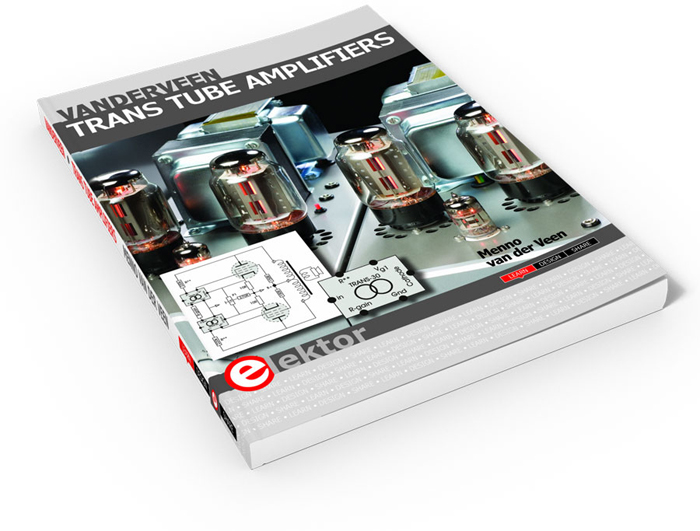audioXpress magazine reviews Vanderveen Trans Tube Amplifiers
His latest book, Vanderveen Trans Tube Amplifiers is a crisp, silver and grey paperback, about a quarter-of-an-inch thick, with a beautifully constructed tube amplifier’s top deck artfully displayed on its cover.
The book delivers in many areas. It is engagingly written, and generally easy to read. Vanderveen Trans Tube Amplifiers moves quickly through an explanation of the author’s specific transimpedance amplifier application to his simple “Transie 1” and “Transie 2” low-power, singleended common-cathode audio amplifiers that are easy to understand, and relatively simple to build. These amplifier designs clearly illustrate the implementation of the transimpedance concept.
By driving a current (rather than voltage) signal into the local feedback loop around an amplifier’s output power tube, and thus lowering the amplifier’s output impedance, van der Veen effectively applies high-gain local feedback around the output power tube to reduce distortion and improves lowfrequency performance (both in the tube and the output transformer that it is driving), all without the stability concerns associated with a global feedback loop.
On the downside, van der Veen’s initial explanation of what he means by a transconductance amplifier is too succinct for most people to understand as they read the text. I had to get out a pencil and paper and re-derive an inverting amplifier’s output impedance, and then replace the input resistor with a voltage-controlled-current source to understand how the current source’s high-output impedance reduces the amplifier’s output impedance by increasing the loop gain. From there, it was a simple step to model and derive the feedback equation for a common-cathode tube amplifier driven in the same way.
As a suggestion for a second edition, replacing the existing appendices (which seem only tangentially related to the book’s technical theme) with some step-by-step derivations of the transconductance amplifier theory as well as some analyses of the transconductance designs presented in the book would further empower readers to apply the transconductance concept to their own original designs.
Just a technical nit: the back cover states, “... transconductance...means converting current into voltage or voltage into current.” This isn’t true. Transconductance is the conversion of voltage into current. Transimpedance is the conversion of current into voltage. Current flowing through an impedance develops a voltage. A resistor (which represents the real—that is, phase independent, part of impedance) is the simplest transimpedance amplifier. Conductance is the inverse of resistance, and transconductance amplifiers (which convert voltage into current) are active devices.

The book delivers in many areas. It is engagingly written, and generally easy to read. Vanderveen Trans Tube Amplifiers moves quickly through an explanation of the author’s specific transimpedance amplifier application to his simple “Transie 1” and “Transie 2” low-power, singleended common-cathode audio amplifiers that are easy to understand, and relatively simple to build. These amplifier designs clearly illustrate the implementation of the transimpedance concept.
By driving a current (rather than voltage) signal into the local feedback loop around an amplifier’s output power tube, and thus lowering the amplifier’s output impedance, van der Veen effectively applies high-gain local feedback around the output power tube to reduce distortion and improves lowfrequency performance (both in the tube and the output transformer that it is driving), all without the stability concerns associated with a global feedback loop.
On the downside, van der Veen’s initial explanation of what he means by a transconductance amplifier is too succinct for most people to understand as they read the text. I had to get out a pencil and paper and re-derive an inverting amplifier’s output impedance, and then replace the input resistor with a voltage-controlled-current source to understand how the current source’s high-output impedance reduces the amplifier’s output impedance by increasing the loop gain. From there, it was a simple step to model and derive the feedback equation for a common-cathode tube amplifier driven in the same way.
As a suggestion for a second edition, replacing the existing appendices (which seem only tangentially related to the book’s technical theme) with some step-by-step derivations of the transconductance amplifier theory as well as some analyses of the transconductance designs presented in the book would further empower readers to apply the transconductance concept to their own original designs.
Just a technical nit: the back cover states, “... transconductance...means converting current into voltage or voltage into current.” This isn’t true. Transconductance is the conversion of voltage into current. Transimpedance is the conversion of current into voltage. Current flowing through an impedance develops a voltage. A resistor (which represents the real—that is, phase independent, part of impedance) is the simplest transimpedance amplifier. Conductance is the inverse of resistance, and transconductance amplifiers (which convert voltage into current) are active devices.

Read full article
Hide full article


Discussion (0 comments)